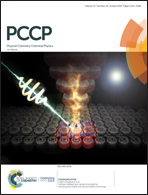Electric field-responsive photoluminescence color switching and reversible properties via Tb/Eu co-doped ergodic relaxor ferroelectrics†
Abstract
A facile strategy of color switching has been developed through reversibly multicolored photoluminescence modulation in dual rare-earth element modified 0.94Bi0.5Na0.5TiO3–0.06BaTiO3 (BNT6BT–Tb/Eu-x) relaxor ferroelectrics via the application of in situ electric fields. By virtue of the chemical and charge disorder induced by the trivalent rare earth ions, more dynamic and weakly correlated polar nanoregions are formed, which facilitate a reversible transition between the randomly oriented polar nanoregions and unstable ordered ferroelectric domains under an electric field. The electroceramics thus become more ergodic, exhibiting giant and reversible electric field-induced strain as well as structural symmetry changes around the luminescent centers and the BNT6BT–Tb/Eu-0.04 sample reveals the highest ergodicity degree. Accordingly, the overall emission color can be modulated reversibly between orange and green by purely physical stimuli (an electric field). The design of the color modulation elucidated in this work should inspire similar research expanded to other soft ferroelectrics for optical tuning and displays at ambient temperature. This should also be helpful for the realization of regulating the physical coupling (photoluminescence color switching-ergodic relaxor ferroelectrics) in multifunctional inorganic materials.



 Please wait while we load your content...
Please wait while we load your content...